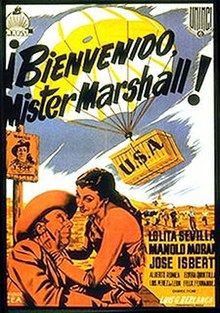fiction.wikisort.org - Movie
Welcome Mr. Marshall! (Spanish: ¡Bienvenido, Mister Marshall!) is a 1953 Spanish comedy film directed by Luis García Berlanga, and considered one of the masterpieces of Spanish cinema. The film highlights the stereotypes held by both the Spanish and the Americans regarding the culture of the other, as well as displays social criticism of 1950s Francoist Spain (showing a typical Spanish village, with typical inhabitants: a priest, the majority of the population that are peasants, the mayor, and a hidalgo). The film was entered into the 1953 Cannes Film Festival.[1]
| Welcome Mr. Marshall! | |
|---|---|
 Theatrical release poster by Francisco Fernández Zarza | |
| Directed by | Luis García Berlanga |
| Written by | Juan Antonio Bardem Luis García Berlanga Miguel Mihura |
| Produced by | Vicente Sempere |
| Starring | José Isbert Manolo Morán Lolita Sevilla |
| Cinematography | Manuel Berenguer |
| Edited by | Pepita Orduna |
| Music by | Jesús García Leoz |
Release date |
|
Running time | 95 minutes |
| Country | Spain |
| Language | Spanish |

Plot
A small Castilian town, Villar del Río is alerted to an upcoming visit of American diplomats; the town begins preparations to impress the American visitors, in the hopes of benefiting under the Marshall Plan. Hoping to demonstrate the side of Spanish culture with which the visiting American officials will be most accustomed, the citizens don unfamiliar Andalusian costumes, hire a renowned flamenco performer, and re-decorate their town in Andalusian style. A flamenco impresario (Manolo Morán) who spent time in Boston advises the locals to think of what they will ask from the Americans.
On the eve of the Americans' visit, three of the central characters dream of stereotypical American culture and history, based uniquely on their lives and experiences. The mayor dreams of a Western-like bar brawl, the hidalgo dreams of the arrival of a conquistador on New World shores, and the priest sees the hoods of a Holy Week procession turn into Klansmen dragging him before the Committee on Un-American Activities accompanied by jazz music. Also, a poorer man dreams that the Americans, shown as the Three Kings, fly over his field and parachute a new tractor into his field.
The day of the Americans' visit arrives and the whole town is prepared to put on a show. However, the American motorcade speeds through the village without stopping. The locals are left to remove the decorations and pay for the expenses with their personal belongings, including the flamenco impresario who gives up a gold ring given to him by the Americans in Boston.
Production
Initially, it was intended as a comic vehicle for the flamenco singer Lolita Sevilla, but Berlanga decided to give it a deeper meaning.
Influence

The title is often mentioned in discussions of American investment in Spain as a caveat against delusion. An example is the 2012-2013 Eurovegas project.[2][3]
The film is one of the influences on the 2019 Spanish comedy film The Little Switzerland.[4]
Cast
- Fernando Rey as Narrator (voice)
- José Isbert as Don Pablo, the mayor, a hearing-impaired old man
- Lolita Sevilla as Carmen Vargas, a flamenco artist from Andalusia
- Alberto Romea as Don Luis, the hidalgo
- Manolo Morán as Manolo, the scheming agent for Carmen Vargas
- Luis Pérez de León as Don Cosme, the priest, concerned about the American heretics
- Elvira Quintillá as Miss Eloísa, the teacher
- Félix Fernández as Don Emiliano, the doctor
- Nicolás D. Perchicot as the pharmacist (as Nicolás Perchicot)
- Joaquín Roa as the town crier
- Fernando Aguirre as the secretary
- José Franco as the general delegate
- Rafael Alonso as the enviado
- José María Rodríguez as José
- Elisa Méndez as Doña Raquel
- Matilde López Roldán as Doña Matilde
References
- "Festival de Cannes: Welcome Mr. Marshall!". festival-cannes.com. Retrieved 24 January 2009.
- Bienvenido, Míster Adelson, Eduardo Muriel, 26 June 2012, Público. The title is changed for Sheldon Adelson.
- Eurovegas No protesta contra el complejo proyectando 'Bienvenido Mr. Marshall', El Mundo (Spain), 26 November 2012. A group campaigning against Eurovegas screens "Welcome Mr. Marshall" as a protest.
- Jiménez, Jesús (26 April 2019). "'La pequeña Suiza', Berlanga inspira una comedia sobre los nacionalismos". RTVE.es (in Spanish). Retrieved 15 February 2022.
External links
- Bienvenido Mister Marshall at IMDb
На других языках
- [en] Welcome Mr. Marshall!
[ru] Добро пожаловать, мистер Маршалл
Добро пожаловать, мистер Маршалл (исп. ¡Bienvenido, Mister Marshall) — испанская кинокомедия 1953 года, поставленная режиссёром Луисом Гарсия Берланга. Этот фильм считается одним из шедевров испанского кинематографа.Другой контент может иметь иную лицензию. Перед использованием материалов сайта WikiSort.org внимательно изучите правила лицензирования конкретных элементов наполнения сайта.
WikiSort.org - проект по пересортировке и дополнению контента Википедии